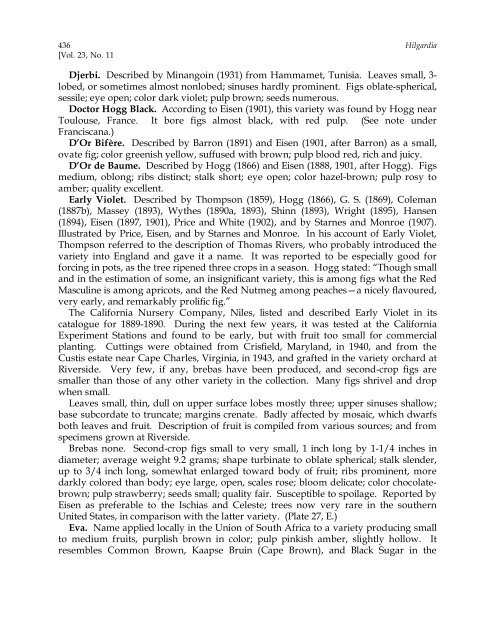Fig Varieties: A Monograph - uri=ucce.ucdavis
Fig Varieties: A Monograph - uri=ucce.ucdavis
Fig Varieties: A Monograph - uri=ucce.ucdavis
Create successful ePaper yourself
Turn your PDF publications into a flip-book with our unique Google optimized e-Paper software.
436 Hilgardia<br />
[Vol. 23, No. 11<br />
Djerbi. Described by Minangoin (1931) from Hammamet, Tunisia. Leaves small, 3-<br />
lobed, or sometimes almost nonlobed; sinuses hardly prominent. <strong>Fig</strong>s oblate-spherical,<br />
sessile; eye open; color dark violet; pulp brown; seeds numerous.<br />
Doctor Hogg Black. According to Eisen (1901), this variety was found by Hogg near<br />
Toulouse, France. It bore figs almost black, with red pulp. (See note under<br />
Franciscana.)<br />
D’Or Bifère. Described by Barron (1891) and Eisen (1901, after Barron) as a small,<br />
ovate fig; color greenish yellow, suffused with brown; pulp blood red, rich and juicy.<br />
D’Or de Baume. Described by Hogg (1866) and Eisen (1888, 1901, after Hogg). <strong>Fig</strong>s<br />
medium, oblong; ribs distinct; stalk short; eye open; color hazel-brown; pulp rosy to<br />
amber; quality excellent.<br />
Early Violet. Described by Thompson (1859), Hogg (1866), G. S. (1869), Coleman<br />
(1887b), Massey (1893), Wythes (1890a, 1893), Shinn (1893), Wright (1895), Hansen<br />
(1894), Eisen (1897, 1901), Price and White (1902), and by Starnes and Monroe (1907).<br />
Illustrated by Price, Eisen, and by Starnes and Monroe. In his account of Early Violet,<br />
Thompson referred to the description of Thomas Rivers, who probably introduced the<br />
variety into England and gave it a name. It was reported to be especially good for<br />
forcing in pots, as the tree ripened three crops in a season. Hogg stated: “Though small<br />
and in the estimation of some, an insignificant variety, this is among figs what the Red<br />
Masculine is among apricots, and the Red Nutmeg among peaches—a nicely flavoured,<br />
very early, and remarkably prolific fig.”<br />
The California Nursery Company, Niles, listed and described Early Violet in its<br />
catalogue for 1889-1890. During the next few years, it was tested at the California<br />
Experiment Stations and found to be early, but with fruit too small for commercial<br />
planting. Cuttings were obtained from Crisfield, Maryland, in 1940, and from the<br />
Custis estate near Cape Charles, Virginia, in 1943, and grafted in the variety orchard at<br />
Riverside. Very few, if any, brebas have been produced, and second-crop figs are<br />
smaller than those of any other variety in the collection. Many figs shrivel and drop<br />
when small.<br />
Leaves small, thin, dull on upper surface lobes mostly three; upper sinuses shallow;<br />
base subcordate to truncate; margins crenate. Badly affected by mosaic, which dwarfs<br />
both leaves and fruit. Description of fruit is compiled from various sources; and from<br />
specimens grown at Riverside.<br />
Brebas none. Second-crop figs small to very small, 1 inch long by 1-1/4 inches in<br />
diameter; average weight 9.2 grams; shape turbinate to oblate spherical; stalk slender,<br />
up to 3/4 inch long, somewhat enlarged toward body of fruit; ribs prominent, more<br />
darkly colored than body; eye large, open, scales rose; bloom delicate; color chocolatebrown;<br />
pulp strawberry; seeds small; quality fair. Susceptible to spoilage. Reported by<br />
Eisen as preferable to the Ischias and Celeste; trees now very rare in the southern<br />
United States, in comparison with the latter variety. (Plate 27, E.)<br />
Eva. Name applied locally in the Union of South Africa to a variety producing small<br />
to medium fruits, purplish brown in color; pulp pinkish amber, slightly hollow. It<br />
resembles Common Brown, Kaapse Bruin (Cape Brown), and Black Sugar in the
















![Fig Trees in North Carolina [Archive] - IDigMyGarden ... - Figs 4 Fun](https://img.yumpu.com/26905320/1/190x245/fig-trees-in-north-carolina-archive-idigmygarden-figs-4-fun.jpg?quality=85)